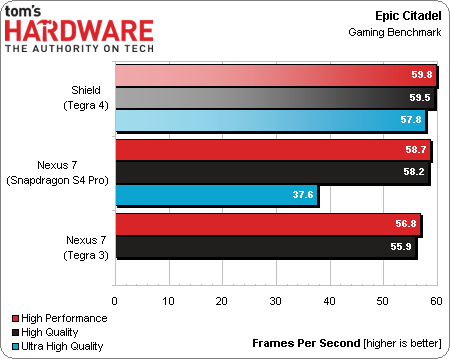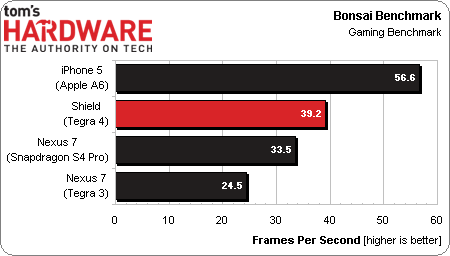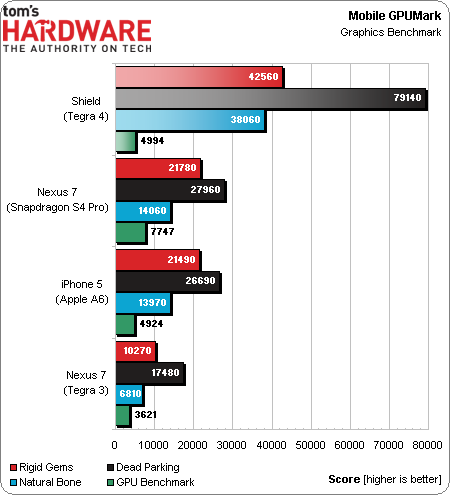Nvidia Shield Review: Tegra 4-Powered Handheld Gaming
We've been playing with Nvidia's Shield handheld for more than a month, but only recently got access to its killer feature: streaming PC game content. Does Nvidia's foray into the hardware world deserve your $300, or is this expensive toy impractical?
Results: Shield And Tegra 4 Graphics
Epic Citadel
Based on the Unreal Engine 3, Epic’s Citadel benchmark gives us some insight into performance—though exclusively at a platform level, since each device runs at its native resolution.
At all three settings, Nvidia’s Shield nearly manages to max out the screen’s 60 Hz ceiling. Both Nexus 7s do as well, so long as you’re using the High Performance and High Quality presets. At Ultra High Quality, the Tegra 3-powered Nexus 7 cannot participate, while the newer version with Qualcomm’s APQ8064 gets hammered pretty hard.
Basemark X
Both iOS- and Android-based devices employ OpenGL ES 2.0 in Basemark X, which centers on the Unity 4.0 game engine.
This test gives us on- and off-screen numbers. Rendering on-screen is faster in almost every case because each device’s native resolution is lower than Basemark’s off-screen target (presumably 1920x1080, given the second-gen Nexus 7’s result).
As a device, Shield can achieve great performance on its five-inch 1280x720 screen. No wonder it gets such solid battery life—Tegra 4 isn’t really having to work very hard to render the same workloads as other SoCs. Of course, when we go off-screen and force each graphics processor to hit the same target, we see Tegra 4 is about four times faster than Tegra 3, and that the Adreno and PowerVR solutions fare comparably.
Get Tom's Hardware's best news and in-depth reviews, straight to your inbox.
Bonsai Benchmark
Rendering to each device’s native resolution, Bonsai Benchmark places Apple’s iPhone 5 in first place (at 640x1135, that’s also the least-taxing workload).
Mobile GPUMark
This benchmark warrants a story until itself, as the lead developer is very open, providing a lot of information about what each sub-test taxes.
We cannot use these scores to compare Tegra 4 to Tegra 3, to A6, or to Qualcomm’s APQ8064 because the scene components run at each device’s native resolution. Only the GPU Benchmark is executed in an off-screen buffer.
With that said, a powerful SoC and 1280x720 display combine to give Shield a massive advantage in all three “game” benchmarks.
Current page: Results: Shield And Tegra 4 Graphics
Prev Page Results: Shield And Tegra 4 Platform Next Page Results: Shield And Tegra 4 Graphics, Continued-
Hazle impressive, especially PC streaming. but for $300, i'd rather pause the game to take a bathroom break. it's gonna take me a library of good android exclusives for me spend that amount of money, and PvsZ or Angry birds don't cut it.Reply -
beta212 Meh, with the PS4/xbox coming out , and tons of more convenient phones I don't see a market for a tegra4 shield, personally I'm saving my money for a console. The tegra is also too expensive and gimmicky to boot.Reply -
dragonsqrrl When you look purely at the performance and specs $300 unsubsidized isn't all that bad considering the hardware you're getting for the price. The problem to me isn't so much price but the target market. How many people are willing to spend that much on a second or potentially third mobile device meant specifically for gaming and entertainment?Reply -
bryonhowley Looks nice but I can find things better to spend $300 on. In truth I can't see ever streaming my PC games to a 5" screen when I use 3 Asus 27" monitors on my desktop PC. Going from 5760x1080 to 720p does not sound like something I am ready to do. And if I want to game from my recliner I just use my Xbox 360 wireless controller and play the game on my Panasonic 50" 3D Plasma.Reply -
vaughn2k for U$180, I can get a nice Lenovo Phone. For U$ 500, a good Xbox.. not sure if I need a Shield where I could play anywhere..Reply -
slomo4sho Not sure why most of your benchmarks were just between the shield and the Nexus 7. I understand that the Nexus 7 utilizes Tegra 3 but the iPhone 5, Note 2, or some other tertiary figues should have been included to provide a better comparison between this device and other current generation products.Reply
This device feels like a universal Wii U game pad and there is almost zero reason to own one. -
cats_Paw Considering that Oculus rift will cost somewhere around 300 dollars as well, id rather wait for that to spend my cash.Reply
Streaming is nice but if you are close toy our pc why not use the PC itself?
-
shikamaru31789 I'm just not seeing much reason to get one right now, not when I'm saving for the Xbox One and PS4. If it was at a lower price and if it supported AMD GPU's for PC streaming, I might get one. But they also need to get some developers to make some good Android exclusives, not just your typical mobile time wasters and ports of older console/PC titles, but some actuallAAA exclusives that are optimized for Tegra 4.Reply




